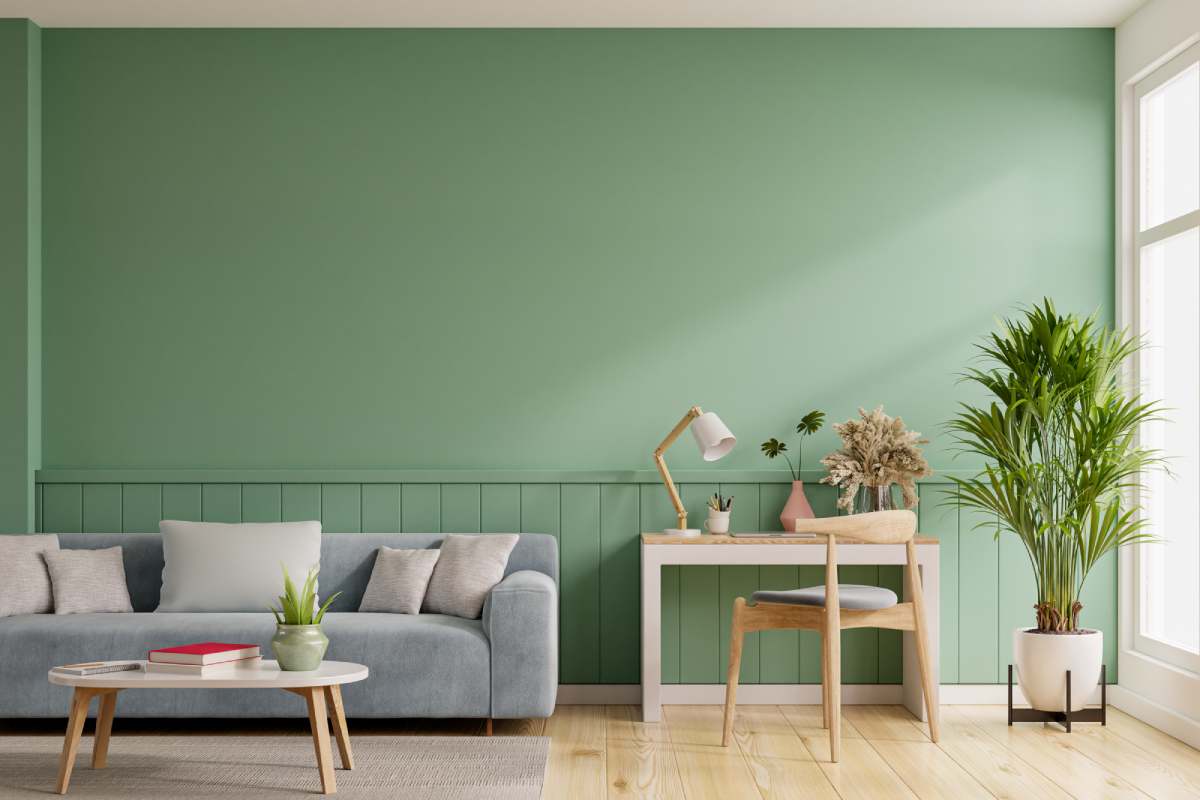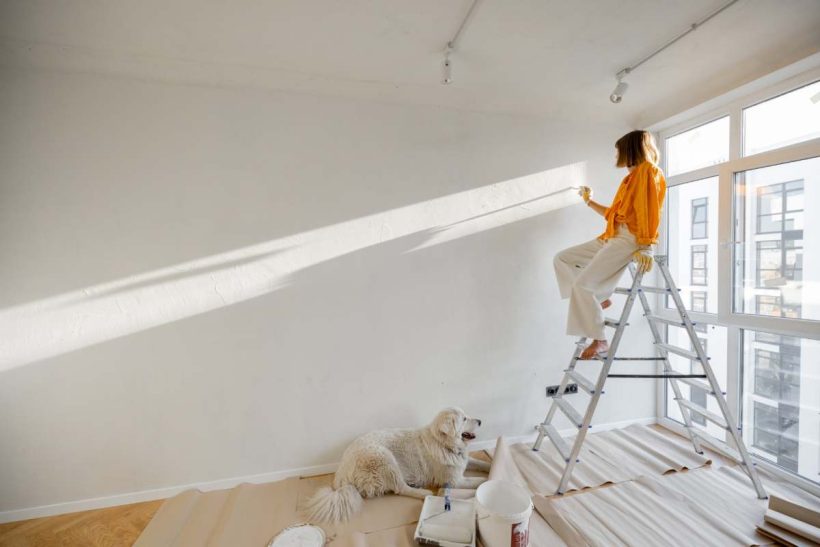When you finish painting a room or a piece of furniture, you might be eager to see the final result and get back to using the space. However, there’s an important step that follows the initial drying—curing. Curing is a crucial phase where the paint undergoes chemical changes to achieve its final strength and durability.
While drying is the initial phase where the paint feels touch-dry, curing continues to harden the paint and improve its resistance to wear and tear. Understanding this process can help you manage expectations and ensure your paint job lasts. Additionally, if you’re looking to speed up this process, there are several strategies you can use to help the paint cure more quickly.
You might also read:
- How to Choose Chandeliers for Ceiling Decoration? What Are the Disadvantages of Chandeliers?
- What is the most common window frame? Can I install a window without the frame? Window frame vs. window trim?
- What is the mechanical plumbing’s scope of work? How much do mechanical plumbers make in Australia?
What is Paint Curing?
When you paint a wall or a piece of furniture, you might notice that the paint doesn’t immediately look perfect. It might feel dry to the touch after a few hours, but that doesn’t mean it’s completely ready. This is where paint curing comes in.
Paint curing is the process by which paint fully hardens and achieves its final properties. While drying is the initial step where the paint feels dry, curing goes a bit further. During curing, the paint undergoes chemical changes that make it stronger, more durable, and more resistant to wear and tear.
How Does It Work?
When you apply paint, it’s usually made up of pigments (the colour), binders (which hold the pigments together), and solvents (which make the paint easy to spread). As the paint dries, the solvents evaporate, leaving behind the pigments and binders. However, the paint isn’t fully set yet. Curing happens as the chemical reactions between the binders and pigments continue over time.
The curing process can vary depending on the type of paint. For instance:
- Latex Paint: This type of paint, which is water-based, generally dries within a few hours but takes about 2 to 4 weeks to fully cure. It’s more flexible and less prone to cracking once cured.
- Oil-Based Paint: Oil-based paints dry slower and might take up to 7 days to dry to the touch. They can take around 1 month to fully cure. These paints are known for their durability and glossy finish.
Why is Curing Important?
Proper curing ensures that the paint reaches its maximum durability and performance. Here are a few reasons why curing matters:
- Durability: Cured paint is more resistant to scratches, stains, and fading. If you don’t allow the paint to fully cure, it might wear out faster or look less vibrant.
- Adhesion: Curing helps the paint bond more effectively to the surface. This means it’s less likely to peel or flake off over time.
- Finish Quality: Curing affects the final look of your paint job. For instance, a gloss finish will look its best once the paint has fully cured.
Tips for Proper Curing
To ensure your paint cures properly, follow these tips:
- Avoid Heavy Use: Don’t place furniture or other items against freshly painted walls until they are fully cured. Heavy use can damage the paint before it’s completely hardened.
- Maintain Good Ventilation: Proper air circulation helps with the curing process. Open windows and use fans to keep the air moving.
- Avoid Moisture: Excessive moisture can interfere with curing. Make sure the room is dry and avoid using humidifiers during this time.
- Follow Manufacturer Instructions: Different paints have different curing times and conditions. Always check the paint can for specific recommendations from the manufacturer.

Does Paint Smell Bad When It’s Not Fully Cured?
If you’ve ever painted a room, you know that distinctive paint smell. It’s common to notice a strong odour right after applying paint, but you might wonder if this smell changes as the paint cures. Let’s explore how paint smell is connected to curing and what you can expect.
Why Does Paint Smell?
Paint smells because of the chemicals in it, especially solvents. Solvents are substances that help the paint spread easily and dry properly. When paint is applied, these solvents evaporate into the air. The smell you notice is often due to these evaporating chemicals.
How Curing Affects Paint Smell
Paint curing is a process where the paint hardens and reaches its final state. This involves chemical reactions that continue even after the paint feels dry to the touch. Here’s how curing affects paint smell:
- Early Stages of Curing: When paint is freshly applied, it releases a lot of volatile organic compounds (VOCs), which contribute to the strong smell. VOCs are chemicals that evaporate quickly and can make the air inside your home smell like paint. During the early stages of curing, when the paint is still drying, the smell can be quite strong.
- Smell Reduction Over Time: As the paint cures, the amount of solvents and VOCs being released decreases. The curing process involves the chemical bonding of pigments and binders, which slowly reduces the need for solvents. Therefore, as curing progresses, the smell of paint gradually fades.
- Fully Cured Paint: Once the paint is fully cured, the smell should be minimal or completely gone. By the time curing is complete, most of the solvents have evaporated, leaving behind a neutral smell. The length of time for paint to fully cure can vary depending on the type of paint and environmental conditions, but it typically ranges from a few weeks to a month.
Factors That Influence Paint Smell
Several factors can affect how long the paint smell lingers:
- Type of Paint: Different paints have different amounts of VOCs. Oil-based paints generally have stronger smells compared to water-based (latex) paints. If you’re using oil-based paint, expect a stronger odour that may take longer to dissipate.
- Ventilation: Good ventilation helps to disperse paint fumes more quickly. Opening windows, using fans, and ensuring good airflow can help reduce the smell faster. Proper ventilation also speeds up the drying and curing process.
- Temperature and Humidity: High temperatures and humidity can affect how quickly paint dries and cures. In warmer, drier conditions, the smell might fade more quickly. Conversely, cooler and more humid conditions can slow down the drying and curing process, potentially prolonging the smell.
Tips to Handle Paint Smell
If you’re dealing with a strong paint smell, here are some tips to help manage it:
- Ventilate the Area: Open windows and use fans to circulate air. This helps to carry away the paint fumes and reduces the smell more quickly.
- Use Air Purifiers: Some air purifiers are designed to capture VOCs and other pollutants. Using one can help improve indoor air quality and reduce paint smell.
- Keep Pets and Children Away: It’s best to keep pets and young children out of freshly painted rooms until the smell has diminished and the paint has fully cured.
- Choose Low-VOC Paints: When possible, opt for low-VOC or no-VOC paints. These paints are formulated to have less odour and are better for indoor air quality.

Can I Accelerate the Curing Process?
Yes, you can take steps to help accelerate the curing process of paint. While you can’t completely bypass the time it takes for paint to cure, these tips can help speed up the process and get your space back to normal sooner:
1. Improve Ventilation
Good airflow helps paint dry and cure faster. Open windows and use fans to keep the air circulating. This helps evaporate solvents more quickly and reduces the drying time. You might also consider using an air purifier designed to remove VOCs from the air.
2. Control Temperature and Humidity
Optimal temperature and humidity levels can accelerate curing. Paint generally cures faster in warmer temperatures and lower humidity. Aim to keep the room temperature between 18°C and 24°C (65°F and 75°F) and humidity levels below 50%. Avoid painting in very cold or very humid conditions, as these can slow down the process.
3. Use a Dehumidifier
If you’re in a humid environment, using a dehumidifier can help reduce moisture in the air, which can speed up the drying and curing process. Lower humidity levels help the paint dry more evenly and quickly.
4. Avoid Heavy Use
While this doesn’t directly speed up curing, avoiding heavy use of painted surfaces can help prevent damage during the curing process. Heavy use or placing objects on fresh paint can interfere with curing and might lead to defects like peeling or smudging.
5. Follow Manufacturer’s Recommendations
Different types of paint have different curing times and conditions. Always follow the manufacturer’s instructions for optimal curing. Some paints come with specific recommendations for temperature and humidity that can help you achieve the best results.
If you’re not sure how each paint works, you should consider hiring a professional like Painting All Sorts near the Central Coast who has experience working with painting for a long time. They can deliver you the finest paint that should satisfy you in the long run.
6. Use Paint Additives
Certain paint additives are designed to speed up drying and curing times. These are usually available at paint supply stores. Check with the paint manufacturer to see if any recommended additives are compatible with your paint and will help accelerate the curing process.
7. Avoid Painting in Direct Sunlight
While it might seem that sunlight would help paint dry faster, direct sunlight can cause the paint to dry too quickly on the surface while the inner layers remain wet. This can lead to issues such as cracking or uneven curing. Instead, aim for a well-lit area with indirect light.
8. Keep Paint Thin
If you’re applying multiple coats, ensure each coat is thin and even. Thick layers of paint take longer to dry and cure. Applying multiple thin coats will generally lead to better results and faster curing.
Conclusion
Paint curing is an essential process that transforms your freshly painted surfaces into durable and long-lasting finishes. Although curing takes time, you can take steps to help accelerate this process and get back to using your space sooner. By improving ventilation, controlling environmental conditions, and following specific tips for optimal curing, you can enhance the efficiency of the curing process and ensure a high-quality result.
Remember, while you can’t completely bypass the curing period, these practices will help you achieve the best outcome and enjoy your newly painted area with minimal delay.










